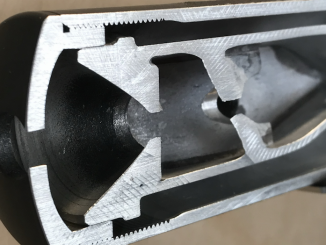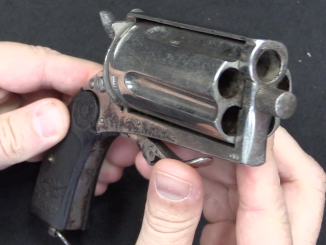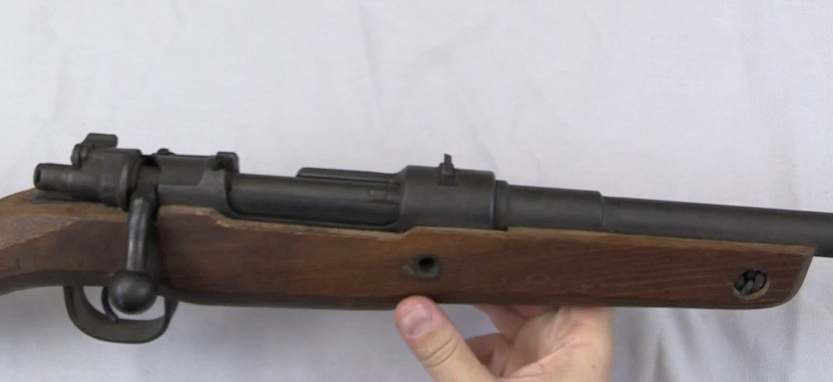I am getting high speed footage of a bunch of interesting pistols right off the bat now that I have my Edgertronic camera, and one that has been on my list ever since I first shot it was the Schwarzlose 1908. It’s a very fast action, and my initial attempts at high speed a year or two ago didn’t turn out well.
Now, however, I have much better gear for this:
The initial footage is at 2000 fps, and then I sped it up to 3500. At that point it is starting to get a bit dark (the Arizona desert sunlight will need an artificial boost if I am to record at any higher of a frame rate, but you can get a pretty clear view of what is happening. It’s awfully crowded inside that action, and I’m really surprised that I haven’t had it malfunction on me. Counting frames of the video gives me a total cyclic rate of 0.024 seconds per shot, or (in theory) 2500 rounds per minute. Wow!




It IS cool footage! So glad you have these new “toys” so you can better document all these Forgotten Weapons.
You are right! Very cool footage. I have been interested in firearm mechanisms for a long long time and I had never heard of a blow forward action. Thanks.
I wonder if there is ANY advantage to a blow forward action, let’s say with a modern damper mechanism to absorb the slide closing? (What is the opposite of recoil, coil?)
A longer barrel (at given OL) is an advantage. Also lack of reciprocating slide can be an advantage … well, in theory … I mean it can let to design higher grip.
However, I think with more powerful cartridges (say 9x19mm) this design will need some kind of locking mechanism (being chambered in .25acp it doesn’t need one).
I read something about old Mannlicher blow-forward rifles.
It appears to work better with more loaded ammunition.
It almost looks like the spinning casing is in hover mode in the first shot from the top. Very cool footage.
Amazing video !!!
Very interesting from an armorers perspective. It appears that the cartridge that is loading moves slightly rearward toward what would previously been called the bolt-face, now the frame-face (?) as the chamber & feed-ramp are forcing it up from its magazine. Will have to replay & view many times. Very cool stuff. Thank you.
What’s the strength of the magazine springs on this pistol? Are they crazy hard to load?
That second round seems to jump up *really* fast, though that may just be the ‘geometry’ of the action.
To be honest it looks like that second round is acting as an ejector to the just fired round.
May I pose a request?
with the photos (and video) in the initial posting showing burning powder in almost every possible opening of the breech, I’d really like to see a Savage 1907 being fired at a high frame rate. I wonder when unlocking really starts – might give quite a few ‘insights’ …
Awesome. I’ve been wanting to see this gun in slow motion for awhile, but not I’m left with more questions.
In the cut-away pictures of the 1908 it looks like the cartridges feeding from the magazine would be caught up at the rear of the shells on the frame of the pistol. In the video it looks like the shells are jumping foward and running up the feed ramp to clear the frame overhang. It looks like momentum is keeping the cartridges stationary while the pistol recoils backwards.
Could you post a video or a description of how a cartridge is fed from the magazine to the breech face? Is it possible to slow feed a cartridge(snapcap) by riding the barrel/slide?
A lug projecting inside at the rear of barrel extention at left kicks the top cartridge forward away of the frame stop to the feeding line when the barrel reaching to a suitable distance from the breech face.
By the way, it would be really interesting to see in slow motion of a Pedersen Toggle Delay at work.
One thing which comes to mind is WHERE is energy for ejection (and looks vigorous enough) coming from. Must be residual gas pressure.
It can be said, that this design works on margin, but same time I hear no repost of failure; most amazing.
The “Extractor” is attached to the standing breech, where it holds the empty in place as the barrel runs forward.
The “ejector” is mounted on the barrel/slide extension on the left hand side, and it hits the case head as the barrel runs forward to open the action.
There certainly seems to ba a lot of energy in the bore friction, reaction of the rifling and air/gas resistance for the exiting hot gasses.
Thank you Keith for clearing me on that. This part is not readily visible (perhaps I should look a patent…)
There should be links to the patent in the comments to Ian’s previous posts about the Schwarzlose BF. Also check out the patents for the Semmerling, which draws heavily on the Scwarzlose design.Ian has also covered it.
PS
I never fully worked out how the SIG AK53 carbine worked. I gather it has a forward moving barrel and a locked breech.
Very nice slo-mo. My reaction was (regular speed) Wow! Now, if I slowed it down to two words a second: I am intrigued by the Schwarzlose’s magazine feed system compared with a rearward-recoiling system. In the latter, the feed lips hold the rear of the cartridge in place and at a forward/upward angle ready to be scooped up by the breech face returning to battery. Along the line posed by ahil925, in the case of the Schwarzlose, how are the cartridges held so that they can present to the returning barrel and then be fed into the chamber?
Ian,
would it be possible for you to give an approximate weight for the barrel, also length of bullet travel, and some indication of rifling pitch please. Oh, and bullet weight too please.
I can’t think it through at the moment, but there is probably enough info in your film and with the requested info to work out how much of an impulse is being given to that barrel – and to see whether the reaction of the rifling to spinning up the accelerating bullet is enough to account for it, and how much additional friction we need to add in to get the observed acceleration of the barrel.
keith,
Consider the initial movement of the bullet into the throat and the engraving of the bullet into the rifling. I have a feeling that the “impact” of the bullet on the throat would account for the majority of energy transfer to the barrel/slide. Once the bullet engraves into the rifling the dynamic friction between bullet and bore and the rotational inertia of the bullet would probably add little to the energy of the slide. A relatively easy way to test this would be to build a test blow forward firearm with an overly long barrel, outfit it with LVDT or accelerometers on the barrel/slide, and fire rounds through it shortening the barrel each time (by back boring?) and adding weight to bring the assembly back to original weight. If the bullet to bore friction and rotational acceleration are large components then you would expect to see the barrel/slide energy drop roughly proportionally to barrel length. Got any spare barrels and DAQ systems hanging about?
And to Ian,
Well done, my friend. I’m so glad you got the camera. You’re obviously puting it to good use. 🙂
Very cool footage
In case a live round thrown into the fire, eventual explosion drives the lesser massed part away thereof as leaving the bigger massed part rather stationary thereat. Blow Forward action should not be different from this event and work same principle with Blow Back. Forwarding bullet is a plug in the bore during its presence at there and excepting the pressure loss through leakage, action/reaction equaliation should be same with Newtons Number three formula. The bigger mass of frame supported by holding rather stationary hand will remain fixed and lesser massed barrel will go forward through momentum share of even lesser massed bullet which acting greater speed as leaving the barrel with rather small forward clearance from the breech end. Unavoıdable recoil of frame will quicken the forwarding action of barrel as creating bigger, risky gap from the breech face and worn rifling will lessen the plugging effect of forwarding bullet. Even a locked breech can be thought through this concept.
@strongarm,
the analogy of a live round in the fire is a bit lacking, I fear. The major issue being the complexity of the system. Newton’s third law (equal and opposite effect) is an apt analogy for that brief moment when the bullet is breaking away from the clutches of the case (held in place by the crimp and inertia), but as soon as the bullet begins its journey downrange things get quite complicated. For the first .020 to .040 inches of travel the bullet is constrained only by the case neck and has yet to contact the barrel. During this time the energy of the gas pressure is being transferred rearward into the case and hence into the frame and forward into the bullet (and radially into the deformation of the case and generally in the form of heat transfer, if we’re to be complete about this). No energy has been transferred to the barrel yet. When the bullet travels far enough to jump the throat and engage the rifling it imparts a small portion of its energy to the barrel. This could be considered an inelastic collision, and given the amount of material on the periphery of the bullet which must deform to allow the bullet into the barrel proper this should be considered a rather large impact. You could calculate the amount of energy transferred through calculating the total deformation of the bullet and the yield strength of the various materials (lead and “copper” jacket, as the temperature rises throughout the impact), but it would probably be easier to build a test rig and measure. Once the bullet engraves into the rifling the transfer of energy between the burning propellant and the barrel is through friction (bullet to barrel and gas to barrel) and through the rotational inertia of the bullet as the rifling tries to spin it faster and faster (proportionally to the linear acceleration of the bullet down the barrel). As Keith mentioned you should be able to calculate the energy transfer from burning propellant to barrel (through the bullet) by rotational inertia by using the barrel rifling twist, bullet muzzle velocity, and the bullet mass and diameter. Simply by calculating the energy necessary to spin the projectile up to its rotational speed will give you the amount of energy transferred to the barrel as axial velocity (this assumes the final rotational velocity of the pistol itself is insignificant, which is not the case with, say, a 1911). It is my contention that the energy transfer due to bullet/barrel friction and due to rotational inertia are significantly less than the energy transfer throughout the engraving period. Again, you could get a pretty good idea by mounting a barrel against a fixed breach such that the barrel can run forward (within limits) on firing. If you had a really fast data aquisition system you might be able to measure the linear velocity of the barrel so as to see the various acceleration phases. The engraving acceleration would be first and would be quite short. Next would be the rotational inertia (while the bullet is undergoing its greatest linear acceleration), which would drop off as the bullet ran down the barrel. Last would be the bullet/barrel friction which should increase with bullet velocity and so should increase until the bullet leaves the barrel. Three distinct phases of acceleration, all of which happen in less than one thousanth of a second. Means you’d have to be recording at about 100kHz, which isn’t unreasonable. I’d love to mess around with this, but I already have too many projects on at the moment. 🙂
Thanks for your interest. Best wishes for success with your projects.
Hi Stingy,
I took this concept one step further and sometimes in middle of last year conceptualized mechanism for firing more potent cartridge such as 9mm Luger while using link imposed between barrel, slide and frame exploiting the effect you just described. One ex-co-worker and friend of mine opined that “the engraving friction would not be enough to hold action to obtain needed time delay” (or similar to that effect). This is just a partial view, as you confirmed.
Looking at your rationale, I can see it is extremely close to my own. I have a suggestion to you: would you like to co-operate with me on such development? We’d have to begin with business & market potential rationale. There is no sense to do investment of any kind, where is no potential and yes, I realize we are some 120 years into pistols development. Conversely, it could be good opportunity to have chunk of fun, regardless.
Hopefully Ian would be so kind to mediate the exchange of address, pending your interest of course. Thanks!
I liked the recoil wave transferred to hand in 0:14
Simply friction and bullet spin within the barrel can not expell the complete bodyment to forward. If the barrel moves forward it is because the pressure affecting the back surface of bullet also pushing the breechpiece rearward. If it were happened through bullet friction and spin, those effects will force and drive the barrel with stationary breechblock to the direction where bullet acts. There is no possibility to make a locked breech blowforward gun through tradititonal applications, but possible by leverage and reboundıng elements directing the backward thrust of barrel and lock system to the forward. Such an embodyment will grant a powerfull pistol being short in overall lenght wıth conventional service pistol barrel.
I concur; see my suggestion to ‘stinky’ on July 26, 7:20AM.
Hi. Denny,
If you mean a cooperation of joint invention. Why not. I have already three utility handgun patents published by USPTO.
Thank you for your interest Strongarm!
My intention would be primarily to verify my concept(s) against sound opposition and than mainly prove it by factual testing. I am not so keen on patent registration, maintenance and enforcement for sake of it; they are costly a mostly counter-productive for a single individual (as opposed to manufacturing company), unless you have sure-bet solution leading to product (assuming access to such facility) or at least sellable design.
Having said this, I noticed your level of expertise for some time and certainly would be interested to converse with you directly, without concrete commitment, if you wished so.
Once your thoughts cleared and solidly formed, you may,at least go for a provisional patent application with minimum of cost for industrial evaluation through manufactururs. I also suffer of financial support and know what it looks like. I shall do my best at any stage of your efforts just for friendship. Ian can kindly give you my e-mail. By the way, I am at age 70.
Here is a link to a computer generated video thing, of the Pederson “toggle” delay, bolt, as used in the Remington R51 if that’s what you mean.
http://www.youtube.com/watch?v=EOxeLEQZNxo
Hi. PDb,
Thanks for your interest.Unfortunatelly it’s not. What I mean is, Toggle Delayed Pedersen Rifle. If you notice, there is not a rational explanation on the documents reachable except the patent text about how this mechanism works. In fact, it is so simple and a clear slow motion footage will be much helpfull for firearm students along with a short description.